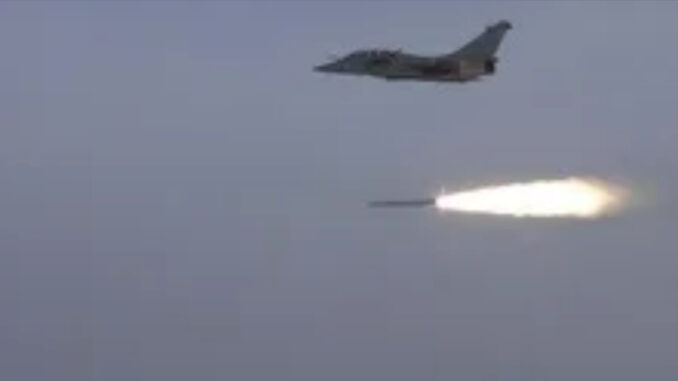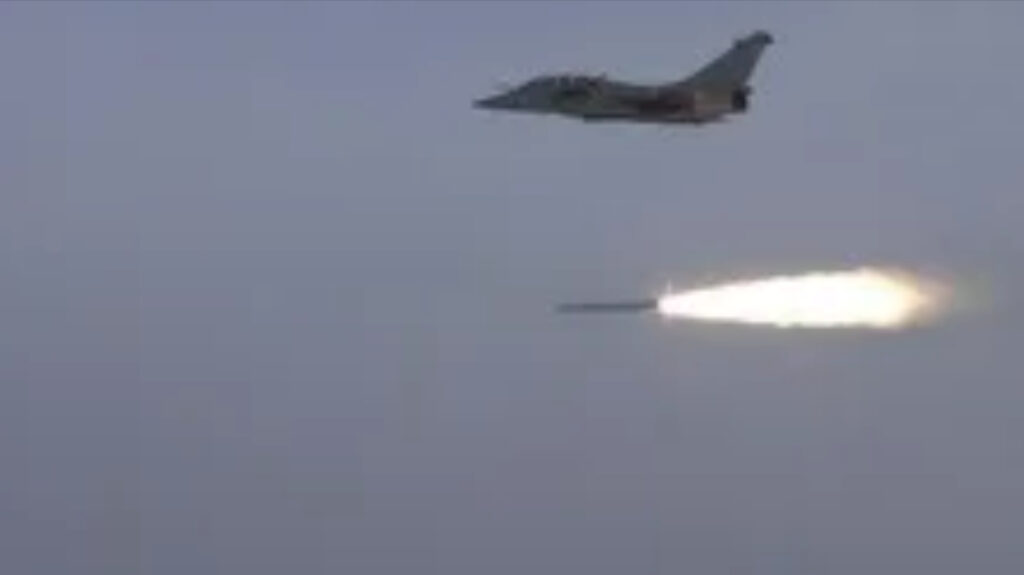
Technical analysis of France’s first firing of the ASMPA-R nuclear missile, its capabilities, development and implications for nuclear deterrence.
Understand in 2 minutes
France carried out the first evaluation firing of its ASMPA-R air-to-ground nuclear cruise missile on May 22, 2024. Launched from a Rafale B during Operation Durandal, this missile demonstrated the advanced capabilities of France’s nuclear deterrent. This development is part of a unique nuclear deterrence strategy, with the possibility of a first-resort strike. The ASMPA-R program aims to reinforce the operational credibility of French forces until the arrival of the ASN4G hypersonic missile in 2035.
On May 22, 2024, France carried out the first evaluation firing of its improved medium-range air-to-ground nuclear cruise missile (ASMPA-R) from a Rafale B aircraft. The test was part of Operation Durandal, designed to simulate a nuclear attack. This article looks in detail at the missile’s technical capabilities, its development, and the strategic implications for France’s nuclear deterrent.
History and development of the ASMPA-R
The ASMPA-R missile is the latest evolution in the Air-to-Ground Medium-Range Missile (ASMP) family, originally developed in 1986. The original ASMP had a range of 80 to 300 km and was equipped with the TN 81 warhead, whose power ranged from 100 to 300 kilotons of TNT. A total of 90 missiles and 80 warheads were produced up to 1991, with 60 units still operational in 2001.
The ASMP-A, an improved version introduced in 2009, extended the range to 500 km and supports a new 300-kiloton thermonuclear warhead. The French air and space force has received 54 of these missiles. The ASMPA-R project aims to further modernize this capability, extending the range and upgrading the warhead to meet the growing threats from opposing air defenses.

ASMPA-R technical specifications
The ASMPA-R missile is designed to offer an increased range over its predecessors, although the exact range remains classified. This increase in range enables French forces to strike more distant targets while remaining out of range of enemy defenses. The missile uses advanced technology to reduce its radar signature, improving its ability to penetrate air defenses.
The ASMPA-R is powered by a ramjet engine, enabling high speeds and enhanced maneuverability. These features are essential for evading modern air defense systems. In addition, the missile is equipped with a new-generation warhead, increasing its destructive effectiveness.
The course of Operation Durandal
Operation Durandal, carried out on May 22, 2024, saw a Rafale B and an A330 Phénix overcome representative air and ground threats before firing the ASMPA-R. The operation was designed to simulate a nuclear raid mission, testing the capabilities of the missile and crew under realistic conditions. The success of this mission was hailed by the French Minister of the Armed Forces, Sébastien Lecornu, who congratulated the Ministry of Defense personnel and industrial partners involved.
French Nuclear Deterrence Strategy
France’s nuclear deterrence policy differs from that of many other nuclear powers, such as the USA and China, which emphasize a policy of non-use as a first resort. In contrast, France maintains the option of striking first in the event of a non-nuclear provocation, underlining its unique deterrent posture.
This strategy aims to deter potential aggression by maintaining a credible and immediate response capability. The development of the ASMPA-R is in line with this logic, ensuring that French forces have the necessary means to maintain an effective and credible deterrent.
Future prospects: ASN4G
The ASMPA-R program is designed to maintain the operational credibility of French forces until the arrival of the ASN4G hypersonic nuclear missile in 2035. This future scramjet-powered missile will offer even more advanced capabilities in terms of range, speed and penetration of enemy defenses. The ASN4G represents the next generation of France’s nuclear deterrent, incorporating the latest technological advances to guarantee impeccable strike capability.
Strategic and geopolitical implications
The successful firing of the ASMPA-R has significant strategic implications. By demonstrating its advanced nuclear strike capabilities, France reinforces its deterrent posture and sends a clear message to potential adversaries. This show of force helps to stabilize the region by deterring any attempts at aggression against French interests.
However, this strategy also entails risks. The first-strike doctrine could be perceived as aggressive, increasing tensions with other nuclear powers. What’s more, the development and deployment of new military technologies could encourage other nations to strengthen their own nuclear capabilities, fuelling a new arms race.
The first evaluation firing of the ASMPA-R nuclear missile marks an important step in maintaining France’s nuclear deterrent capability. With significant improvements in range and penetration capabilities, the ASMPA-R ensures that French forces remain at the cutting edge of military technology. In the long term, the arrival of the ASN4G in 2035 will further strengthen this position, ensuring that France has the necessary means to defend its national interests.
War Wings Daily is an independant magazine.